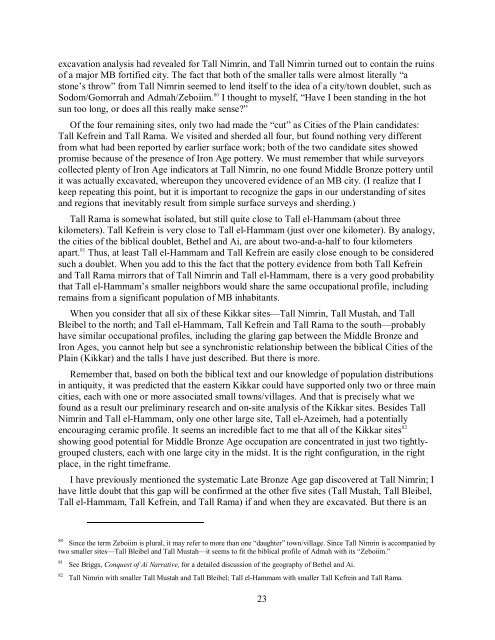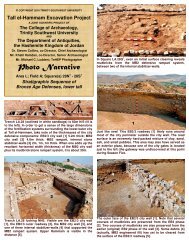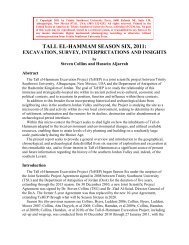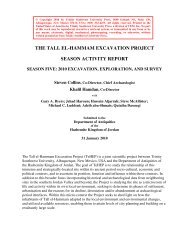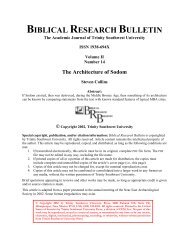Explorations on the - Tall el-Hammam Excavation Project, Jordan
Explorations on the - Tall el-Hammam Excavation Project, Jordan
Explorations on the - Tall el-Hammam Excavation Project, Jordan
You also want an ePaper? Increase the reach of your titles
YUMPU automatically turns print PDFs into web optimized ePapers that Google loves.
excavati<strong>on</strong> analysis had revealed for <strong>Tall</strong> Nimrin, and <strong>Tall</strong> Nimrin turned out to c<strong>on</strong>tain <strong>the</strong> ruins<br />
of a major MB fortified city. The fact that both of <strong>the</strong> smaller talls were almost literally “a<br />
st<strong>on</strong>e’s throw” from <strong>Tall</strong> Nimrin seemed to lend its<strong>el</strong>f to <strong>the</strong> idea of a city/town doublet, such as<br />
Sodom/Gomorrah and Admah/Zeboiim. 80 I thought to mys<strong>el</strong>f, “Have I been standing in <strong>the</strong> hot<br />
sun too l<strong>on</strong>g, or does all this really make sense?”<br />
Of <strong>the</strong> four remaining sites, <strong>on</strong>ly two had made <strong>the</strong> “cut” as Cities of <strong>the</strong> Plain candidates:<br />
<strong>Tall</strong> Kefrein and <strong>Tall</strong> Rama. We visited and sherded all four, but found nothing very different<br />
from what had been reported by earlier surface work; both of <strong>the</strong> two candidate sites showed<br />
promise because of <strong>the</strong> presence of Ir<strong>on</strong> Age pottery. We must remember that while surveyors<br />
collected plenty of Ir<strong>on</strong> Age indicators at <strong>Tall</strong> Nimrin, no <strong>on</strong>e found Middle Br<strong>on</strong>ze pottery until<br />
it was actually excavated, whereup<strong>on</strong> <strong>the</strong>y uncovered evidence of an MB city. (I realize that I<br />
keep repeating this point, but it is important to recognize <strong>the</strong> gaps in our understanding of sites<br />
and regi<strong>on</strong>s that inevitably result from simple surface surveys and sherding.)<br />
<strong>Tall</strong> Rama is somewhat isolated, but still quite close to <strong>Tall</strong> <strong>el</strong>-<strong>Hammam</strong> (about three<br />
kilometers). <strong>Tall</strong> Kefrein is very close to <strong>Tall</strong> <strong>el</strong>-<strong>Hammam</strong> (just over <strong>on</strong>e kilometer). By analogy,<br />
<strong>the</strong> cities of <strong>the</strong> biblical doublet, Be<strong>the</strong>l and Ai, are about two-and-a-half to four kilometers<br />
apart. 81 Thus, at least <strong>Tall</strong> <strong>el</strong>-<strong>Hammam</strong> and <strong>Tall</strong> Kefrein are easily close enough to be c<strong>on</strong>sidered<br />
such a doublet. When you add to this <strong>the</strong> fact that <strong>the</strong> pottery evidence from both <strong>Tall</strong> Kefrein<br />
and <strong>Tall</strong> Rama mirrors that of <strong>Tall</strong> Nimrin and <strong>Tall</strong> <strong>el</strong>-<strong>Hammam</strong>, <strong>the</strong>re is a very good probability<br />
that <strong>Tall</strong> <strong>el</strong>-<strong>Hammam</strong>’s smaller neighbors would share <strong>the</strong> same occupati<strong>on</strong>al profile, including<br />
remains from a significant populati<strong>on</strong> of MB inhabitants.<br />
When you c<strong>on</strong>sider that all six of <strong>the</strong>se Kikkar sites—<strong>Tall</strong> Nimrin, <strong>Tall</strong> Mustah, and <strong>Tall</strong><br />
Bleib<strong>el</strong> to <strong>the</strong> north; and <strong>Tall</strong> <strong>el</strong>-<strong>Hammam</strong>, <strong>Tall</strong> Kefrein and <strong>Tall</strong> Rama to <strong>the</strong> south—probably<br />
have similar occupati<strong>on</strong>al profiles, including <strong>the</strong> glaring gap between <strong>the</strong> Middle Br<strong>on</strong>ze and<br />
Ir<strong>on</strong> Ages, you cannot h<strong>el</strong>p but see a synchr<strong>on</strong>istic r<strong>el</strong>ati<strong>on</strong>ship between <strong>the</strong> biblical Cities of <strong>the</strong><br />
Plain (Kikkar) and <strong>the</strong> talls I have just described. But <strong>the</strong>re is more.<br />
Remember that, based <strong>on</strong> both <strong>the</strong> biblical text and our knowledge of populati<strong>on</strong> distributi<strong>on</strong>s<br />
in antiquity, it was predicted that <strong>the</strong> eastern Kikkar could have supported <strong>on</strong>ly two or three main<br />
cities, each with <strong>on</strong>e or more associated small towns/villages. And that is precis<strong>el</strong>y what we<br />
found as a result our pr<strong>el</strong>iminary research and <strong>on</strong>-site analysis of <strong>the</strong> Kikkar sites. Besides <strong>Tall</strong><br />
Nimrin and <strong>Tall</strong> <strong>el</strong>-<strong>Hammam</strong>, <strong>on</strong>ly <strong>on</strong>e o<strong>the</strong>r large site, <strong>Tall</strong> <strong>el</strong>-Azeimeh, had a potentially<br />
encouraging ceramic profile. It seems an incredible fact to me that all of <strong>the</strong> Kikkar sites 82<br />
showing good potential for Middle Br<strong>on</strong>ze Age occupati<strong>on</strong> are c<strong>on</strong>centrated in just two tightlygrouped<br />
clusters, each with <strong>on</strong>e large city in <strong>the</strong> midst. It is <strong>the</strong> right c<strong>on</strong>figurati<strong>on</strong>, in <strong>the</strong> right<br />
place, in <strong>the</strong> right timeframe.<br />
I have previously menti<strong>on</strong>ed <strong>the</strong> systematic Late Br<strong>on</strong>ze Age gap discovered at <strong>Tall</strong> Nimrin; I<br />
have little doubt that this gap will be c<strong>on</strong>firmed at <strong>the</strong> o<strong>the</strong>r five sites (<strong>Tall</strong> Mustah, <strong>Tall</strong> Bleib<strong>el</strong>,<br />
<strong>Tall</strong> <strong>el</strong>-<strong>Hammam</strong>, <strong>Tall</strong> Kefrein, and <strong>Tall</strong> Rama) if and when <strong>the</strong>y are excavated. But <strong>the</strong>re is an<br />
80 Since <strong>the</strong> term Zeboiim is plural, it may refer to more than <strong>on</strong>e “daughter” town/village. Since <strong>Tall</strong> Nimrin is accompanied by<br />
two smaller sites—<strong>Tall</strong> Bleib<strong>el</strong> and <strong>Tall</strong> Mustah—it seems to fit <strong>the</strong> biblical profile of Admah with its “Zeboiim.”<br />
81 See Briggs, C<strong>on</strong>quest of Ai Narrative, for a detailed discussi<strong>on</strong> of <strong>the</strong> geography of Be<strong>the</strong>l and Ai.<br />
82 <strong>Tall</strong> Nimrin with smaller <strong>Tall</strong> Mustah and <strong>Tall</strong> Bleib<strong>el</strong>; <strong>Tall</strong> <strong>el</strong>-<strong>Hammam</strong> with smaller <strong>Tall</strong> Kefrein and <strong>Tall</strong> Rama.<br />
23


